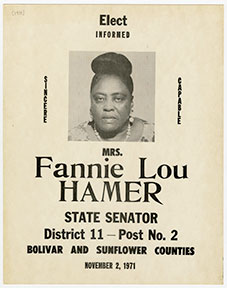From Sharecropper to Freedom Fighter:
The Life of Fannie Lou Hamer
By James Monaghan, Asolo Repertory Theatre
1917— Fannie Lou was the twentieth child born into her Mississippi sharecropper family. She began picking cotton at age six and, by the sixth grade, dropped out of school to work the fields full time.
1945—While serving as a timekeeper on the same plantation from her childhood, Fannie Lou married Perry Hamer, a tractor driver who worked alongside her. The plantation owner valued her literacy skills, which she had picked up through Bible study. Throughout her career, she was disparaged for her simple southern roots, but her early appreciation for literacy and Christianity shaped her commitment to social justice.
1962—After becoming involved with the Student Nonviolent Coordinating Committee (SNCC), Fannie Lou and fellow activists attempted to register to vote, but were met with police pushback and a discriminatory literacy test. Fannie Lou was then kicked off the plantation and survived 16 drive-by shootings while in hiding.
1963—On her third attempt, Fannie Lou passed the voter registration test, but faced another barrier with the county poll tax, designed to discriminate against poor black citizens. These experiences spurred Fannie Lou to lead voter registration and education initiatives through SNCC and the Southern Christian Leadership Conference. She continued her community organizing work even after a brutal police beating left her with lasting injuries.
1964—The Democratic National Convention featured Fannie Lou giving a passionate address about racial equity on behalf of the Mississippi Freedom Democratic Party, which she had founded to challenge her state’s prejudiced, all-white delegation. She also ran a campaign for congress that, while unsuccessful, elevated her national platform. That same year, she worked with Freedom Summer organizers to train college students in civil rights activism strategies, including movement songs—something she became known for in this community.
1965—President Lyndon B. Johnson signed the Voting Rights Act into law, but Fannie Lou’s work was far from over. She assisted in numerous legal challenges to southern discrimination against black voters and organized a school desegregation lawsuit.
1969—After another failed bid for congress in 1967, Fannie Lou turned her attention to black poverty, housing and food insecurity back in Mississippi. She created Freedom Farms, an agriculture and economic development project to support impoverished black families.

1971—Following a third and final unsuccessful run for office, Fannie Lou co-founded the National Women’s Political Caucus and encouraged women to see the intersections of race and gender discrimination. Her voting rights activism later in her career focused on involving women in causes of racial justice, class disparity, and political advocacy.
1977—At age 59, Fannie Lou died of complications from breast cancer and her funeral was attended by hundreds of Mississippi locals along with dignitaries and prominent civil rights leaders. She is remembered for her fearless approach to advocacy for black Americans’ right to political participation and social equality.